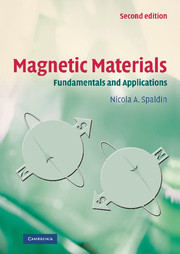Book contents
- Frontmatter
- Contents
- Acknowledgments
- I Basics
- 1 Review of basic magnetostatics
- 2 Magnetization and magnetic materials
- 3 Atomic origins of magnetism
- 4 Diamagnetism
- 5 Paramagnetism
- 6 Interactions in ferromagnetic materials
- 7 Ferromagnetic domains
- 8 Antiferromagnetism
- 9 Ferrimagnetism
- 10 Summary of basics
- II Magnetic phenomena
- III Device applications and novel materials
- Epilogue
- Solutions to selected exercises
- References
- Index
1 - Review of basic magnetostatics
from I - Basics
Published online by Cambridge University Press: 05 June 2012
- Frontmatter
- Contents
- Acknowledgments
- I Basics
- 1 Review of basic magnetostatics
- 2 Magnetization and magnetic materials
- 3 Atomic origins of magnetism
- 4 Diamagnetism
- 5 Paramagnetism
- 6 Interactions in ferromagnetic materials
- 7 Ferromagnetic domains
- 8 Antiferromagnetism
- 9 Ferrimagnetism
- 10 Summary of basics
- II Magnetic phenomena
- III Device applications and novel materials
- Epilogue
- Solutions to selected exercises
- References
- Index
Summary
Mention magnetics and an image arises of musty physics labs peopled by old codgers with iron filings under their fingernails.
John Simonds, Magnetoelectronics today and tomorrow, Physics Today, April 1995Before we can begin our discussion of magnetic materials we need to understand some of the basic concepts of magnetism, such as what causes magnetic fields, and what effects magnetic fields have on their surroundings. These fundamental issues are the subject of this first chapter. Unfortunately, we are going to immediately run into a complication. There are two complementary ways of developing the theory and definitions of magnetism. The “physicist's way” is in terms of circulating currents, and the “engineer's way” is in terms of magnetic poles (such as we find at the ends of a bar magnet). The two developments lead to different views of which interactions are more fundamental, to slightly different-looking equations, and (to really confuse things) to two different sets of units. Most books that you'll read choose one convention or the other and stick with it. Instead, throughout this book we are going to follow what happens in “real life” (or at least at scientific conferences on magnetism) and use whichever convention is most appropriate to the particular problem. We'll see that it makes most sense to use Système International d'Unités (SI) units when we talk in terms of circulating currents, and centimeter–gram–second (cgs) units for describing interactions between magnetic poles.
- Type
- Chapter
- Information
- Magnetic MaterialsFundamentals and Applications, pp. 3 - 13Publisher: Cambridge University PressPrint publication year: 2010
- 1
- Cited by



